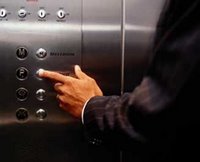At the request of my 4 year old, last Friday I headed to one of my favorite sandwich shops for lunch. I love the sandwiches and my daughter loves the pizzas. We entered the restaurant at 11:50.
Clue #1 There was only one table with 2 ladies eating in the whole restaurant.
Clue #2 There were no customers in line at the order counter.
So my daughter and I approached the order counter and waited a few seconds.
Clue #3 There was no employee standing at the order counter to take our order.
We waited a few more seconds. Finally, the employee working at the drive through window saw us standing at the counter, looked around and yelled, "Where's Melanie?"
Clue #4 After a few more seconds Melanie still did not appear.
Clue #5 Finally Melanie appeared with a telephone in her hand, looked at me, continued talking on the phone, held up her pointer finger and mouthed, "Just one second." She talked for a while longer and then disappeared behind a wall to continue her conversation.
All of this at ten of noon on a Friday, with no one in line in front of me or behind me at a nationally known sandwich shop on the busiest boulevard in the city. As someone who has spent her entire professional life working to satisfy customers I was irritated. Now I knew why the sandwich shop had no one in line at 11:50 on a Friday.... bad customer service.
Know what I did? I left. Even though I was craving the food, even though my 4 year old had lobbied hard to eat there, even though I was first in line.... I left. I chose not to give this business my money. And I will not go back. And I blabbed to my friends about the bad experience.
But this situation could have been easily turned around by the business. What if "Melanie" had followed me out to my car and said, "I am so sorry, I should not have been talking on the phone. Please come back in. I'll give you and your daughter free drinks and cookies with your meal." Think I would have changed my mind? You bet!
The extra effort to regain my business would have left an even bigger impression than if the whole lunch experience had been just satisfactory to begin with. As a small business owner, an unsatisfied customer represents an opportunity to create a customer for life. Here are some tips for handling upset customers and turning them into your biggest fans:
- LISTEN to why the customer is upset. Don't defend yourself or your business.
- Acknowledge and apologize for what has happened but don't explain why it happened. In my case, Melanie could have said, "I apologize that you were having to wait on me. I am sorry I kept you waiting." A bad way for her to apologize is, "I am sorry I was on the phone but my ex-husband hasn't paid child support in 2 months and that was a creditor on the phone...blah, blah, blah."
- Confirm that you understand why the customer is unhappy. Ask questions to clarify what you THINK you heard the customer say. Examples are, "What you are saying is.... right?" or "I'm not sure I understand fully, could you tell me more about....." or "What you were hoping for was..... is that right?"
- Propose a solution that will satisfy the customer. It is very important not to overpromise. Know what you can realistically do to solve the problem and then execute.
- Follow up to confirm that the solution did indeed rectify the problem. The sandwich shop employee could have personally checked on me while I was eating my meal to see if I was satisfied. When I worked for Otis Elevator I would frequently drive to a customer's building to "check on" a fixed elevator (even though the mechanic had told me it was running). When I worked for a medical diagnostic company I would call a customer to verify that the replacement reagents had arrived the next day (even though I had seen the FedEx confirmation). As a small business owner you want to get credit for "solving" your customer's problem. Don't miss the opportunity to follow up on a corrected situation to confirm the customer's satisfaction and so that your customer can acknowledge the corrective actions of your business.


